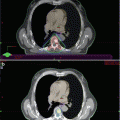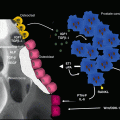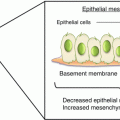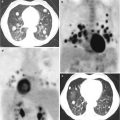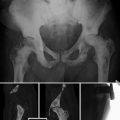Fig. 12.1
Representation of two models of development of castration-resistant prostate cancer (CRPC) from castration-sensitive prostate cancer (CSPC). ADT androgen deprivation therapy. Androgen-dependent prostate cancer cells are represented in blue, androgen-resistant cells in red and yellow
Preclinical studies with in vivo prostate cancer models have demonstrated that simultaneous androgen deprivation and chemotherapy are more effective than sequential treatment [22, 23]. The combination of chemotherapy with ADT has been first explored in metastatic CRPC. In the pivotal TAX327 trial, comparing docetaxel chemotherapy with mitoxantrone [24], and in the SWOG9916 trial, comparing the combination of docetaxel and estramustine with the same control arm [25], patients continued ADT throughout study treatment, to ensure continued androgen ablation. Medical castration was continued also in patients enrolled in the TROPIC trial, showing a survival improvement with cabazitaxel as compared to mitoxantrone in patients with disease progression during or after docetaxel-based chemotherapy [26]. On the contrary, in all these studies, at least 4 weeks had to have elapsed between the withdrawal of antiandrogens (6 weeks in the case of bicalutamide) and enrollment, so as to avoid the possibility of a confounding effect as a result of the response to antiandrogen withdrawal.
Early targeting of cells that survive hormonal therapy may potentially prevent the development of CRPC. The aim of these therapeutic strategies is the elimination of resistant cells at the time the tumor is apparently “androgen sensitive.” More than 10 years ago, preclinical studies in mice had suggested that the earlier use of chemotherapy with taxanes (i.e., before the development of castration resistance) was therapeutically advantageous [22, 23]. On the other hand, more recent data have shown evidence of inhibition by taxanes of nuclear translocation of the androgen receptor. In vitro, exposure of PC cells to paclitaxel inhibited the translocation by targeting association of the androgen receptor with tubulin. Moreover, when tissue microarrays of PC patients treated with docetaxel were compared to those of docetaxel-untreated patients, a significant decrease in nuclear androgen receptor concentration was observed, paralleled by an increase in cytosolic expression [27].
12.3 Clinical Trials of Chemotherapy in Metastatic Castration-Sensitive Prostate Cancer
Based on this preclinical rationale, several trials have explored the use of combination therapy with ADT and chemotherapy, targeting both the androgen dependent and independent cells simultaneously, rather than waiting for CRPC to establish. In the past decades, several randomized trials had failed to demonstrate a survival improvement with this strategy [28–32]; however, these older trials were limited by the small sample size and by the use of drugs such as mitomycin C, estramustine phosphate, and weekly epirubicin, with no proven activity in PC. Following the results of the TAX327 study [24], docetaxel was extensively evaluated in combination with ADT in men with hormone-naïve metastatic PC, in the attempt to improve the duration and quality of patient survival. Three large randomized phase III trials evaluating the combination of docetaxel with ADT versus ADT alone in metastatic castration-sensitive PC (CSPC) have been recently reported (Table 12.1): the GETUG-AFU 15 study [33, 34], the CHAARTED trial [35], and the STAMPEDE study, a large phase III trial with multiple treatment arms evaluating multiple stages of PC [36, 37].
Table 12.1
Studies adding docetaxel to ADT in metastatic CSPC
GETUG-15 | CHAARTED | STAMPEDE (metastatic patients onlyb) | |
|---|---|---|---|
N. of patients (ADT-docetaxel/ADT) | 385 (192/193) | 790 (397/393) | 1086 (724/362) |
Median FUa | 83 months | 29 months | 43 months |
Median agea | 64 years | 63 years | 65 years |
De novo metastatic patientsa | 272 (71 %) | 575 (73 %) | 1037 (95 %) |
Disease volumea | |||
High volume/risk | 183 (48 %) | 513 (65 %) | UK |
Low volume/risk | 202 (52 %) | 277 (35 %) | UK |
Visceral metastasesa | 51 (13 %) | 123 (16 %) | UK |
Bone metastasesa | |||
Overall | 311 (81 %) | UK | 941 (87 %) |
High volume for bone metastases only | 177 (46 %) | 389 (49 %) | UK |
Gleason score ≥ 8a | 216 (56 %) | 484 (61 %) | 70 %b |
N. of planned docetaxel cycles | 9 | 6 | 6 |
Grade ≥3 Toxicity (docetaxel arm) | |||
Neutropenia | 32 % | 12 % | 12 % |
Febrile neutropenia | 7 % | 6 % | 12 % |
Median OS (HR, 95 % CI; p value) | |||
Whole population | 48.6 vs 62.1 months HR 0.88 (0.68–1.14) p = 0.3 | 44.0 vs 57.6 months HR 0.61 (0.47–0.80) p < 0.001 | 45.0 vs 60.0 months HR 0.76 (0.62–0.92) p = 0.005 |
High volume/risk | 35.1 vs 39.8 months HR 0.78 (0.56–1.09) p = 0.1 | 32.2 vs 49.2 months HR 0.60 (0.45–0.81) P < 0.001 | UK |
Low volume/risk | 83.4 months vs NR HR 1.02 (0.67–1.55) p = 0.9 | NR vs NR HR 0.60 (0.32–1.13) p = 0.11 | UK |
12.4 The GETUG-AFU 15 Trial
The GETUG-AFU 15 study was an open-label, randomized phase III study that assessed the addition of docetaxel to ADT in men with metastatic CSPC. Between October 2004 and December 2008, 385 patients were randomized from 30 centers (29 in France and 1 in Belgium) in a 1:1 ratio to receive ADT (orchiectomy or luteinizing hormone-releasing hormone agonists, alone or combined with nonsteroidal antiandrogens) or ADT plus docetaxel 75 mg/m2 every 3 weeks for nine cycles [33, 34] (Table 12.1). Randomization was stratified according to treatment for primary PC, systemic therapy for biochemical relapse, and risk groups as defined by Glass et al. [38]. Glass risk groups had been developed within a large-scale randomized clinical trial comparing orchiectomy and flutamide to orchiectomy and placebo in CSPC patients. Risk factors included appendicular versus axial metastatic disease, Eastern Cooperative Oncology Group (ECOG) performance status 0 versus 1–3, PSA less than 65 versus 65 ng/ml or greater, and Gleason score less than 8 versus 8 or greater. Using these criteria three prognostic groups were developed, including a good (hazard ratio – HR-1), intermediate (HR 1.8), and poor (HR 2.8) group.
In GETUG-AFU 15 study, eligible patients had histologically confirmed adenocarcinoma of the prostate with radiologically proven metastases, were older than 18 years, and had a Karnofsky PS ≥70 %, a life expectancy of at least 3 months, and adequate hematological, hepatic, and renal function. The use of a short course of ADT was allowed for up to 2 months before study entry. The primary end point of the study was OS. Efficacy analyses were done by intention to treat. The original results of the study, after a median 50 months follow-up, were published in 2013 [33]; an updated long-term OS analysis with a median follow-up of 82.9 months was reported in 2015 [34]. The majority of patients enrolled in the study were metastatic at diagnosis (72 %), whereas the remaining patients had developed metastases following treatment of localized disease. A significant improvement in the predefined secondary end points of both biochemical and clinical progression-free survival (PFS) was reported for ADT plus docetaxel versus ADT alone. Namely, a 10-month improvement in median biochemical PFS was found (22.9 versus 12.9 months, HR 0.7, p = 0.0021). However, no statistically significant difference in the primary end point of OS between the two treatment groups was observed: median OS was 60.9 (95 % CI 46.1–71.4) months in the ADT plus docetaxel versus 46.5 (95 % CI 39.1–60.6) months in the ADT-alone treatment arm (HR = 0.9; p = 0.44). At the time of final analysis, all patients were retrospectively classified based on the tumor volume as defined per the CHAARTED study criteria (high volume defined as visceral metastases and/or four or more bone metastases with at least one outside the vertebral column and pelvis) [35]. In the overall population, the median OS was not significantly different between the two arms: 62.1 months (95 % CI, 49.5–73.7) in the ADT plus docetaxel arm and 48.6 months (95 % CI, 40.9–60.6) in the ADT arm (HR 0.88 [95 % CI, 0.68–1.14]; p = 0.3). The OS of high-volume patients did not differ significantly according to the assigned treatment, with a median value of 39.8 (95 % CI 28.0–53.4) months for ADT plus docetaxel versus 35.1 (95 % CI 29.9–43.6) months in the ADT-alone treatment arm (HR: 0.78 [95 % CI, 0.56–1.09]; p = 0.14). In patients with low-volume disease, median OS was not reached (NR; 95 % CI 69.5–NR) in the ADT plus docetaxel arm and 83.4 months (95 % CI 61.8–NR) in the ADT arm (HR: 1.02 [95 % CI 0.67–1.55]; p = 0.9). The test of homogeneity of treatment effects among high- and low-volume subgroups did not reveal a significant difference between the estimated HRs in the two subgroups (p = 0.40). Patients with metastatic disease after failure of local treatment had a significantly longer median OS than those with metastases at diagnosis (83.1 versus 46.5 months, HR: 1.57 [95 % CI, 1.09–2.26]; p = 0.015). No survival difference was observed within each of these two groups according to treatment. Median time to subsequent treatment was longer in the ADT plus docetaxel arm: 28.1 versus 18.5 months, respectively. In the ADT arm, 127 of 149 patients (85 %) received docetaxel at progression (91 % in the high volume and 78 % in the low-volume subgroup). Other treatments administered after progression in a minority of patients were abiraterone acetate, enzalutamide, and cabazitaxel.
Serious adverse events were more common in the group given ADT plus docetaxel. The most frequent were neutropenia (21 %), febrile neutropenia (3 %), and abnormal liver function tests (2 %). Four treatment-related deaths (5 %) occurred in the ADT plus docetaxel group (two of which were neutropenia related); as a consequence, the data monitoring committee recommended prophylaxis with granulocyte colony-stimulating factor. After this recommendation, no further treatment-related deaths occurred. No serious adverse events were reported in the ADT-alone group.
12.4.1 The CHAARTED Trial
The CHAARTED trial also investigated the addition of docetaxel to ADT in metastatic hormone-sensitive disease [35]. In this trial 790 men with metastatic PC, enrolled between July 2006 and November 2012, were randomized 1:1 to receive ADT alone or ADT plus 75 mg/m2 of docetaxel every 3 weeks for six cycles (Table 12.1). Premedication comprised oral dexamethasone 8 mg at 12 h, 3 h, and 1 h before docetaxel infusion; daily prednisone was not required. Randomization was allowed within 4 months of initiating ADT. Most patients enrolled in the study had metastases at diagnosis (75 %), and the remaining had developed metastases following treatment of local disease. Patients were stratified by volume of disease (high versus low), with high-volume disease defined as visceral metastases and/or four or more bone metastases with at least one beyond the pelvis and the axial skeleton. Other stratification factors included: age (≤70 versus >70 years), ECOG PS (0–1 versus 2), prior adjuvant ADT (>12 months or ≤12 months), and concurrent bisphosphonate or denosumab use (yes versus no). The primary end point was OS; secondary end points were PSA response (PSA <0.2 ng/ml at 6 and 12 months), time to clinical (radiographic or symptomatic) progression, time to CRPC (including biochemical progression), treatment tolerability, and quality of life. Patient characteristics were well balanced between the two arms. Median age was 64 years in the combination group and 63 years in the ADT-alone group. In both groups, approximately 70 % had an ECOG PS score of 0, approximately 65 % had high-volume disease, and 60 % had a Gleason score of 8 or higher. At a planned interim analysis, prespecified criteria for significance were met, and the data were released; the median follow-up was 28.9 months. The primary end point was met, with an improvement in the median OS of the whole study population of 13.6 months in the combined treatment arm (57.6 versus 44.0 months, HR 0.61, 95 % CI 0.47–0.80, p < 0.001). In a subset analysis, the greatest difference in median OS between the two treatment arms (17 months) was observed in patients with high-volume disease. In this subgroup (514 patients), median OS was 49.2 months for patients treated with ADT plus docetaxel versus 32.2 months for those treated with ADT alone (HR 0.60, 95 % CI 0.45–0.81, p < 0.001). The median OS was not reached at the time of the analysis in the cohort of patients with low-volume disease, with no statistically significant difference between the two treatment arms (HR 0.60, 95 % CI 0.32–1.13, p = 0.11). The combination of ADT and docetaxel also met all the secondary end points. The median time to biochemical, symptomatic, or radiographic progression was 20.2 months in the combination group, as compared with 11.7 months in the ADT-alone group (HR 0.61, 95 % CI 0.51–0.72; P < 0.001). PSA response (as defined above) at 12 months was 27.7 % in the combination group versus 16.8 % in the ADT-alone group (P < 0.001). The reported toxicity in the combination arm was mild, with grade 3–4 neutropenia observed in 12.1 % of patients, and anemia, thrombocytopenia, and febrile neutropenia reported in 1.3 %, < 1 %, and 6.1 % of cases, respectively. Grade 3 peripheral neuropathy occurred in 1 % of patients. More than 85 % of patients completed all the six planned cycles of docetaxel, three quarters of them without dose modifications. One treatment-related death occurred in the docetaxel plus ADT arm; no deaths related to treatment toxicity were reported in the ADT-alone arm.
12.4.2 The STAMPEDE Trial
STAMPEDE is a large ongoing phase III trial with a multi-arm multistage design [36, 37]. Patients with high-risk locally advanced or metastatic prostate cancer, or with aggressively relapsing disease after initial therapy for local disease, and starting long-term ADT for the first time were enrolled. The study was opened to accrual in October 2008 in several centers in the United Kingdom and Switzerland. The hypothesis was that the early use of active therapies might give a large absolute benefit in OS, set as the primary study end point. Secondary outcome measures were failure-free survival (FFS), toxicity, quality of life, skeletal-related events (SREs), and cost effectiveness. FFS was defined as first of PSA failure, local or lymph node failure, distant metastases, and prostate cancer death. The first trial design included five research arms, but arms with celecoxib (ADT plus celecoxib and ADT plus celecoxib and zoledronic acid) were closed for lack of sufficient activity at a preplanned interim analysis [39]. The remaining original arms – ADT plus docetaxel, ADT plus zoledronic acid, and ADT plus the combination of docetaxel and zoledronic acid – successfully completed their recruitment throughout all interim stages in March 2013. An arm of abiraterone, prednisone, and ADT was introduced in November 2011, and its accrual was completed in January 2014 [40]. A new arm with radiotherapy, among newly diagnosed metastatic patients only, was introduced in January 2013, and another arm combining enzalutamide, abiraterone, and prednisone with ADT started in July 2014 [41]. The survival results for three research comparisons testing the addition of zoledronic acid, docetaxel, or both to ADT (considered as the control arm) in patients with M0 or M1 hormone-sensitive disease have been recently reported [37]. Patients were randomized 2:1:1:1 to standard ADT versus ADT plus docetaxel, zoledronic acid, or both, respectively. Age, stage, the presence of metastases, previous treatments, center, and the use of aspirin or non-steroid anti-inflammatory drugs were stratification factors. Docetaxel was given at 75 mg/mq every 3 weeks for six cycles with prednisolone 10 mg daily; zoledronic acid was administered at 4 mg every 3 weeks for six cycles (18 weeks), then every 4 weeks until 2 years. Primary end point of the study was OS. Overall, 2962 men were randomized to the four arms. Median age was 65 years (range 40–84), and 78 % of patients had ECOG PS 0. Most patients (61 %) had metastatic PC, in 85 % of cases with bone metastases. The remainder had either lymph node metastases with M0 status (15 %) or N0M0 disease (24 %). Radiotherapy was delivered in patients with N0M0 disease and was optional for men with N-positive M0 disease. With a median follow-up of 43 months, patients treated with ADT alone had a median OS of 71 months, and 5-year survival was 55 %. These data were the reference for each comparison of research groups with control. A statistically significant improvement in OS was reported in patients treated with ADT plus docetaxel, with a median OS of 81 months and a 5-year OS of 63 % (HR 0.78, 95 % CI 0.66–0.93; p = 0.006). Similarly, patients treated with ADT plus docetaxel plus zoledronic acid had a longer median OS of 76 months and a 5-year OS of 60 % (HR 0.82, 95 % CI 0.69–0.97; p = 0.022). On the contrary, no OS improvement was reported in the arm of patients treated with ADT plus zoledronic acid (HR 0.94, p = 0.45). In a preplanned subset analysis, adding docetaxel to standard ADT showed significant OS improvement in patients with metastatic status but not in M0 patients; similar results were found in the subgroup of patients in which docetaxel and zoledronic acid were added to standard ADT. Namely, median OS of 362 metastatic patients treated with docetaxel plus ADT was 60 months as compared to 45 months of 724 metastatic patients treated with ADT alone, with an HR of 0.76 (95 % CI 0.62–0.92) and a p = 0.005. FFS was significantly longer in patients receiving ADT plus docetaxel or ADT plus docetaxel and zoledronic acid. The effect of docetaxel on FFS was maintained in both metastatic and nonmetastatic patients. No effect on FFS was observed when adding zoledronic acid alone to ADT. Treatments used at progression included docetaxel in 41 % of patients enrolled in the standard arm; abiraterone acetate, enzalutamide, cabazitaxel, and radium 223 were equally distributed in the study arms. Grade 3–5 toxicity was more frequent in the docetaxel arms (52 % in docetaxel and docetaxel/zoledronic acid groups versus 32 % in the ADT arm). Febrile neutropenia rate was significantly higher in the docetaxel arms (14 % and 15 %, respectively, versus 1 % in the standard arm). In conclusion, addition of docetaxel to ADT improved OS in metastatic CSPC. Zoledronic acid did not improve OS. Addition of both agents to ADT improved OS but offered no obvious benefit over adding just docetaxel. According to the authors, docetaxel should be considered in routine practice for suitable men with newly diagnosed metastatic disease and also for selected men with high-risk nonmetastatic disease in view of substantial prolongation of FFS.
Stay updated, free articles. Join our Telegram channel

Full access? Get Clinical Tree



